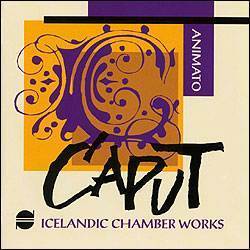 [1] Icelandic Dances [3:27] Jón Leifs (1899-1968)
flute, clarinet, violin, cello and piano
Arranged by Atli Heimir Sveinsson (1938)
[2] Elja [10:54] Áskell Másson (1953)
Conductor: Guðmundur Óli Gunnarsson
[3] Tales from a Forlorn Fortress [10:50] Lárus H. Grímsson (1954)
bassoon, violin, viola and cello
[4] String Quartet [9:34] Snorri Sigfús Birgisson (1954)
[5] Trio Animato [9:27] Haukur Tómasson (1960) [Special thanks to RUV]
[6] Vink II [3:56] Atli Ingólfsson (1962)
piccolo, clarinet, violin, viola, cello, and piano
[7] Romanza [14:58] Hjálmar H. Ragnarsson (1952)
flute, clarinet and piano
World Premiére Recording
Produced my the Icelandic Music Information Centre ITM 8-08, Reykjavík, 1995
The CAPUT Ensemble opens this disc with the typically Icelandic musical heritage of the rímur songs, similtaneously honouring two of the most importanta Icelandic musicains of the 20th century, Jón Leifs (1899-1968), the musical pioneer of the first par ot the century, and Atli Heimir Sveinsson (b.1938), the revolutionary of the latter par of the century who imtroduced Iceland to new ideas about the composition of music.
Rímnadansar op. 14 (Icelandic Dances) by Jón Leifs is here performed in the arrangement of Atli Heimir Sveinsson for flute, clarinet, violin, cello and piano. The arrangement dates from 1994, light, playful and sparkling with the humour that characerises so much that the composer has written. Atli Heimir Sveinsson arranged the dances for CAPUT for their concert in Wigmore Hall in London in June 1994.
Elja for chamber group by Áskel Másson was compose for the CAPUT Ensemble in 1994 and premièred at the Myrkir Músíkdagar in February 1995. Myrkir Músíkdagar (Dark Music Days) is the biennal music festival held in Reykjavík by the Society of Icelandic Composers and provides an opportunity to hear a large number of new Icelandic compositions. The work is written for ten instruments: flute (and piccolo), oboe, clarinet (and bass clarinet), bassoon (and contra bassoon), horn, first and second violins, cello and double bass. It is in one movement divided into an energetic and exciting introduction (allegretto), a calm middle section (andante), and a short coda (allegretto, moderato) that brings the work to a quiet and tranquil end. The old Icelandic theme of the Elja Poem is heard in three places, in the first section, at the end of the first and beginning of the second section, and again at the end of the work. "Elja" is an old word, said of a woman, who competes with other women for a man's attention, a lover or a mistress. A newer meaning of the word denotes eagerness and struggle, and the title of the work points first and foremost to this newer meaning fo the word. For this work the conductor of the CAPUT Ensemble is Guðmundur Óli Gunnarsson.
Tales from a Forlorn Fortress by Lárus H. Grímsson was composed for bassoon, viola, and cello in 1993. This short chamber music piece is divided into a slow, lyrical introduction for the cello (with the background voices of the violin and viola) and a slightly faster main section where the bassoon usually has the principal part, playing against the strings. The piece is virtually a short concerto for bassoon and strings and, in fast, the composer says he had especially in mind the very gifted bassoon player, Brjánn Ingason. In light of the name of the piece, the listener can play with the idea that the bassoon is the voice of the storyteller.
String Quartet, op. 2 by Snorra Sigfús Birgisson was composed in 1991 and premièred at the CAPUT concert for Myrkir Músíkdagar in February 1995. The three sections of the quartet are played without a break. The composer says of the work: "The first section is longest, composed of various musical ideas that, however, lead in the same direction. The second section is more uniform in character but heads in several directions at once. The final section is very shrot and nods its head three times to the other two."
Trio Animato by Hauk Tómasson was composed for CAPUT in 1993. The work is written for clarinet, cello and double bass and divided into six sections in which the instruments play at creating their own voices in a weaving of sound based on differing unison and polyphonic passages.
Vink II by Atla Ingólfsson is scored for violin, cello, piccolo, clarinet and piano. It was originally composed on the occasion of the 50th anniversary of the founding of the town of Njarðvík and revised for the CAPUT concert in Wigmore Hall in June 1994 under the title Vink II.
Romanza, trio for flute, clarinet and piano by Hjálmar H. Ragnarsson, composed in 1981, was premièred in Reykjavík and Stockholm by Manuela Wiesler, flautist, Einar Jóhannesson, clarinettist and Þorkell Sigurbjörnsson, composer and pianist. The work has since been performed widely in other parts of the world. The composer here plays with many opposites, not only in the tonal treatment, subject matter and ideas between the contrasting main sections of the work, but he also intensifies the contrasts between the insturments themselves. In order to emphasise contrastive characteristics of the piece the composer named it "Romanza", a name that shouts the contrast between the word itself and the musical worlds that the listener is invited to enter. From the CD brochure. © 1995 Jón Örn Marinósson; translation: Terry G. Lacy |
